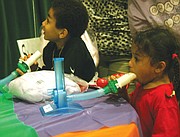Asbestos research projects reach public through unique event
Canda Harbaugh | Hagadone News Network | UPDATED 15 years, 3 months AGO
Researchers study Libby’s unique asbestos fiber, analyze statistics of people who suffer medical complications from it, and examine the social and psychological impacts that it has had on the community.
A Research Rally last Thursday, sponsored by the Center for Asbestos Related Disease, served to connect community members with those who are performing the various studies.
“It’s important (for locals) to attach a name to a face,” said CARD clinical coordinator Kimberly Rowse, “so they feel comfortable and trusting and are able to ask questions about research that is going on, and see how the researchers aren’t behind microscopes and white coats.”
Organizers agree that the rally’s carnival theme – with free popcorn, cotton candy, snow cones, balloons and educational, research-relevant games – was a hit. The after-school event at the Memorial Center drew in families that could play games and then listen to short presentations and ask questions.
“The turnout is great,” CARD director Dr. Brad Black said Thursday as he looked around. “I see a lot of people here asking questions of the researchers because they have health problems that relate directly to their asbestos exposure. They talk to researchers who are working on that and they can see firsthand that they have a great interest in solving the problems related to the asbestos.”
Some portions of the community have had negative perceptions about outsiders studying the people of Libby for personal gain, but the CARD clinic, led by a board of locals, works as a filter, according to Black.
“The goal of CARD was to make sure that people interested in doing research were there to really do research that would benefit people in the community,” he explained. “Our board of directors always wanted to make sure that we are in that role of protecting the people of Libby from unnecessary research. We feel the research should have meaning and point to directions to help solve our problems and look for finding some effective therapies.”
Dr. Stephen Levin of the Mount Sinai School of Medicine in New York described at the rally his work in comparing CT scans of pipefitters and insulators who were constantly exposed to usual forms of asbestos with those of local residents who suffered non-occupational exposure to Libby amphibole asbestos.
By comparing the two, researchers may be able to learn how the unique asbestos fibers cause scarring of the lungs. If they understand the mechanism, Levin explained, they may be able to discover treatment to stop the process.
Work has begun in New York, and the team will start seeing people at the CARD clinic in Libby within a couple of months.
“It’s our hope,” Levin said, “that in looking at the difference between what happens in Libby with this type of asbestos and what happens with people exposed to the usual forms of asbestos, we’ll have a shot at identifying ways to intervene.”
The psychological impact of Libby’s “slow-motion disaster,” consequences of childhood exposure and how to achieve community-based participatory research were also topics that were discussed.
The Community Advisory Group, Technical Advisory Group, Environmental Protection Agency and Lincoln County Health Department also collaborated to provide a panel discussion immediately after the rally regarding health risk assessment and epidemiology studies.
Research grants are generally accompanied by a responsibility to somehow inform the community, Black said, and a Research Rally may be the way that CARD gets the word out about projects in the future.
“Our desire was to make it a very positive event and, hopefully, people become interested and see the importance in what is happening in research and that it does have meaning in the community,” he said.
ARTICLES BY CANDA HARBAUGH

Flood 1169
By early afternoon flood victims began pumping water out of their basements. Don Emery, whose rental home is pictured, also began packing his belongings into a moving truck.

Flood 0893
Rosie Roberts looks outside her window on West 10th Street before evacuating her home. Minutes later, a stronger current of water broke through, causing authorities to close the street.

Flood 0992
Workers travel Nevada Avenue by way of back hoe. City and county crews, as well as a few contractors, helped break up the stream's ice with excavators in order to prevent further ice jams.



